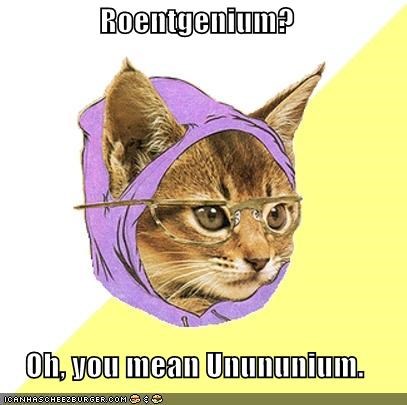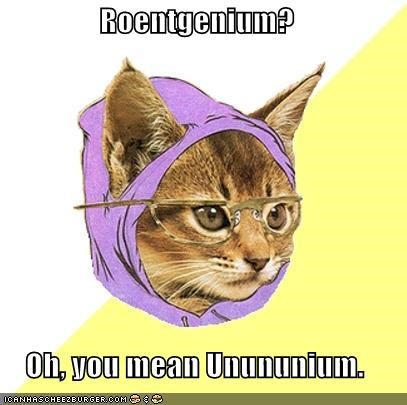Element of the week: roentgenium
 Image: Cheezburger.
Image: Cheezburger.
This week’s element is roentgenium, which has the atomic symbol, Rg, and atomic number, 111. Originally known by its temporary name, unununium (Uuu), this element was named in honour of German physicist Wilhelm Conrad Röntgen, who discovered X-rays and who, in 1901, was awarded the first ever Nobel Prize in physics.
Roentgenium is predicted to be a noble metal (it is resistant to corrosion and oxidation in moist air) that is solid at room temperature and a pale silver-colour. It is predicated to be extremely dense (roughly 28.7 g/cm3) — denser even than osmium, which is the heaviest known element with a density of 22.61 g/cm3.
Like all the other super-heavy synthetic elements, roentgenium does not exist in the wild, although intriguingly, it may occur naturally in trace amounts as a primordial element. This is based on the claim in 2006 that two isotopes of roentgenium (261 and 265) were detected in a sample of natural gold — which is roentgenium’s “little sister” element, occurring immediately above it on the periodic table.
As with all the other synthetic elements, roentgenium is radioactive and extremely unstable. Seven isotopes have been detected so far; the most stable of which is roentgenium-281, with a half-life of 26 seconds. All of its isotopes decay by releasing high energy alpha particles (helium nuclei) — except roentgenium-281, which undergoes spontaneous fission to give rise to several smaller elements.
Roentgenium was first created by the Gesellschaft für Schwerionenforschung (GSI) near Darmstadt, Germany in 1994. One atom of roentgenium-272 was created by bombarding bismuth-209 with nickel-64 and repeated that experiment in 2002, creating three more atoms of roentgenium-272. This isotope has a half-life of roughly 3.8 milliseconds.
Roentgenium has no uses whatsoever.
In this video, our favourite chemistry professor visits GSI and tells us how these monster-sized elements are synthesised, detected and why it takes so long to confirm their existence:
Video journalist Brady Haran is the man with the camera and the University of Nottingham is the place with the chemists. You can follow Brady on twitter @periodicvideos and the University of Nottingham on twitter @UniofNottingham
You’ve already met these elements:
Darmstadtium: Ds, atomic number 110
Meitnerium: Mt, atomic number 109
Hassium: Hs, atomic number 108
Bohrium: Bh, atomic number 107
Seaborgium: Sg, atomic number 106
Dubnium: Db, atomic number 105
Rutherfordium: Rf, atomic number 104
Lawrencium: Lw, atomic number 103
Nobelium: No, atomic number 102
Mendelevium: Md, atomic number 101
Fermium: Fm, atomic number 100
Einsteinium: Es, atomic number 99
Californium: Cf, atomic number 98
Berkelium: Bk, atomic number 97
Curium: Cm, atomic number 96
Americium: Am, atomic number 95
Plutonium: Pu, atomic number 94
Neptunium: Np, atomic number 93
Uranium: U, atomic number 92
Protactinium: Pa, atomic number 91
Thorium: Th, atomic number 90
Actinium: Ac, atomic number 89
Radium: Ra, atomic number 88
Francium: Fr, atomic number 87
Radon: Rn, atomic number 86
Astatine: As, atomic number 85
Polonium: Po, atomic number 84
Bismuth: Bi, atomic number 83
Lead: Pb, atomic number 82
Thallium: Tl, atomic number 81
Mercury: Hg, atomic number 80
Gold: Au, atomic number 79
Platinum: Pt, atomic number 78
Iridium: Ir, atomic number 77
Osmium: Os, atomic number 76
Rhenium: Re, atomic number 75
Tungsten: W, atomic number 74
Tantalum: Ta, atomic number 73
Hafnium: Hf, atomic number 72
Lutetium: Lu, atomic number 71
Ytterbium: Yb, atomic number 70
Thulium: Tm, atomic number 69
Erbium: Er, atomic number 68
Holmium: Ho, atomic number 67
Dysprosium: Dy, atomic number 66
Terbium: Tb, atomic number 65
Gadolinium: Gd, atomic number 64
Europium: Eu, atomic number 63
Samarium: Sm, atomic number 62
Promethium: Pm, atomic number 61
Neodymium: Nd, atomic number 60
Praseodymium: Pr, atomic number 59
Cerium: Ce, atomic number 58
Lanthanum: La, atomic number 57
Barium: Ba, atomic number 56
Cæsium: Cs, atomic number 55
Xenon: Xe, atomic number 54
Iodine: I, atomic number 53
Tellurium: Te, atomic number 52
Antimony: Sb, atomic number 51
Tin: Sn, atomic number 50
Indium: In, atomic number 49
Cadmium: Cd, atomic number 48
Silver: Ag, atomic number 47
Palladium: Pd, atomic number 46
Rhodium: Rh, atomic number 45
Ruthenium: Ru, atomic number 44
Technetium: Tc, atomic number 43
Molybdenum: Mo, atomic number 42
Niobium: Ni, atomic number 41
Zirconium: Zr, atomic number 40
Yttrium: Y, atomic number 39
Strontium: Sr, atomic number 38
Rubidium: Rr, atomic number 37
Krypton: Kr, atomic number 36
Bromine: Br, atomic number 35
Selenium: Se, atomic number 34
Arsenic: As, atomic number 33
Germanium: Ge, atomic number 32
Gallium: Ga, atomic number 31
Zinc: Zn, atomic number 30
Copper: Cu, atomic number 29
Nickel: Ni, atomic number 28
Cobalt: Co, atomic number 27
Iron: Fe, atomic number 26
Manganese: Mn, atomic number 25
Chromium: Cr, atomic number 24
Vanadium: V, atomic number 23
Titanium: Ti, atomic number 22
Scandium: Sc, atomic number 21
Calcium: Ca, atomic number 20
Potassium: K, atomic number 19
Argon: Ar, atomic number 18
Chlorine: Cl, atomic number 17
Sulfur: S, atomic number 16
Phosphorus: P, atomic number 15
Silicon: Si, atomic number 14
Aluminium: Al, atomic number 13
Magnesium: Mg, atomic number 12
Sodium: Na, atomic number 11
Neon: Ne, atomic number 10
Fluorine: F, atomic number 9
Oxygen: O, atomic number 8
Nitrogen: N, atomic number 7
Carbon: C, atomic number 6
Boron: B, atomic number 5
Beryllium: Be, atomic number 4
Lithium: Li, atomic number 3
Helium: He, atomic number 2
Hydrogen: H, atomic number 1
Here’s the Royal Society of Chemistry‘s interactive Periodic Table of the Elements that is just really really fun to play with!




